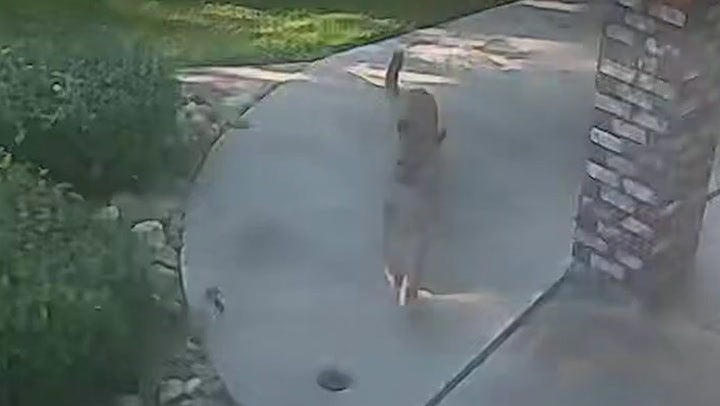Security dog sniffs out mummified monkeys in airport luggage
Security dog sniffs out mummified monkeys in airport luggage
Airport staff were shocked after a security dog sniffed out something unusual in luggage from a traveller returning from Africa – mummified monkeys.
The passenger returning from a visit to the Democratic Republic of Congo reported that the luggage contained dried fish, but an inspection at Boston Logan Airport revealed the dead and dehydrated bodies of four monkeys, agents said.
The traveller said he brought the monkeys into the US for his own consumption, Ryan Bissette, a Customs and Border Protection (CPB) spokesperson, said on Sunday.
Raw or minimally processed meat from wild animals, sometimes referred to as “bushmeat,” is banned in the US because of the threat of disease.
"The potential dangers posed by bringing bushmeat into the United States are real. Bushmeat can carry germs that can cause illness, including the Ebola virus,” said Julio Caravia, local port director for CPB.
It is even thought one or more HIV strains originated from bushmeat hunters in central and western Africa.
The incident happened last month but was made public on Friday.
Mr Bissette said Sunday that no charges were filed but all of the luggage was seized and the nearly 9lb of bushmeat was marked for destruction by the US Centers for Disease Control and Prevention.
Earlier this month, a Brazilian woman travelling to Sao Paulo via Panama was charged with wildlife trafficking after 130 harlequin frogs were seized from her luggage.
The alleged smuggler was arrested at Bogota’s El Dorado international airport by authorities after the poisonous animals were discovered packaged inside small film canisters.
Officials described the amphibians, also known as poison-dart frogs, to be in a “dehydrated” and “stressed” condition.
Story by Via AP news wire: The Independent:
What is a Canada lynx? And should you be afraid of them?
![]()
![]()
![]()
![]()
![]()
![]()
![]()
What is a Canada lynx? And should you be afraid of them?
Hiking in the northern states and Canada can be an opportunity to get your eyes on some truly awe-inspiring wildlife, from giant bovines and hulking Ursidae to big prowling, purring cats. Almost all of these animals aren’t nearly as interested in us as we are in them, so seeing any animal like a bear or wild cat can be pretty exciting – but it can also be scary, especially if you don’t know exactly what you’re looking at, or whether it poses a threat to you.
A healthy amount of fear can be a good thing when it comes to wildlife safety, as hopefully it cuts down on the amount of tourists posing for photos with alligators, but sometimes too much fear can endanger animals. One beautiful animal that’s often misunderstood is the Canada lynx, an evasive furball that pads around on the prowl in northern climes. If you’ve seen such an animal when winter hiking in the north, read on for everything you need to know about this amazing creature.
What is a Canada lynx?
The Canada lynx is a mid-sized wildcat that predominantly dwells in dense borealis forest and makes up one of four species in the lynx family, alongside its cousin, the bobcat. With long black tufts on their triangular ears and black tips on their bobbed tails, this distinctive cat typically stands about 20 inches tall at the shoulder, ranges from about 29 to 43 inches long and can weigh up to 24 lbs – about twice the weight of a house cat.
During the colder months, the Canada lynx sports a thick, gray coat that turns thinner and light brown in summer. Tufts of fur that grow out of their cheeks make their faces appear wide. Their large paws act like natural snowshoes, allowing them to tiptoe around the powder looking for prey, which they do at night. When they set their sights on a tasty-looking snowshoe hare – their primary food source – they’re not sprinters so they must lie in wait and pounce at the right time.
Because they’re so dependent on snowshoe hare for survival, the population density of the two species is closely correlated. When snowshoe hares aren’t available, they’ll also feed on small mammals and birds, though have been known to also eat large mammals like caribou, according to Canadian Geographic.
Where can you find Canada lynx?
Canada lynx is distributed across much of Canada and Alaska but you can also find them in smaller populations in the US. According to the National Wildlife Federation, the presence of stable lynx populations has been confirmed in Maine, Montana, Washington and Colorado, where no more than about 200 of them are thought to live.
The nocturnal Canada lynx is an extremely elusive species. Not only do they shy away from humans everywhere, their population has been threatened by habitat destruction and competition with coyotes, especially in the US and southeastern Canada. Reintroduction measures have been in place in parts of the US over the decades, and they have been listed as threatened in the lower 48 under the Endangered Species Act since 2000. So while Canada lynx can be found in many parts of North America, to come across one on your travels would be very rare and special indeed.
Are Canadian lynx aggressive?
Many North American hikers can be fearful of wildlife, and with grizzly bears, wolves, mountain lions and alligators on the trail, it’s not necessarily that surprising. However, much like their bobcat cousins, you’re extremely unlikely to encounter a Canada lynx on the trail and you probably have nothing to fear if you do as they are not human predators or naturally aggressive.
Though Canada lynx will stalk and kill animals for food and in self-defense against other animals, they’re most likely to give you a wide berth unless you’re trying to corner them for a photograph, getting too close to their young or they are sick.
That said, just like with a bobcat, if you are lucky enough to see a Canada lynx while you’re out snowshoeing, take care to secure your pets and children and practice the following precautions:
- Don't approach it. Respect all wildlife by keeping your distance. Remember, you're a guest in their house, not the other way around.
- Don't try to feed it.
- Don’t turn your back on the lynx. Keep facing it and back away slowly and deliberately to make space between you.
- Don’t run as it may provoke the lynx into instinctively pursuing you.
- If the lynx is acting aggressively towards you, start making a lot of noise. Use your voice, bear bells, beat your trekking pole against a tree, blow your hiking whistle – basically whatever you have at your disposal.
Story by Julia Clarke: Adventure
Mountain lions are elusive, looking for food, and more likely to attack if you’re moving. What’s a cyclist to do?
![]()
![]()
![]()
![]()
![]()
![]()
![]()
Mountain lions are elusive, looking for food, and more likely to attack if you’re moving. What’s a cyclist to do?
The first attack came out of nowhere.
Keri Bergere and her four friends, all competitive women cyclists in their 50s and 60s, were riding along a gravel trail through a picturesque Washington forest when two mountain lions crossed their path. One of the animals kept going; the other, a 75-pound young male, unexpectedly – and terrifyingly – pounced.
The lion knocked 60-year-old Bergere off her bike and to the ground, clamping his powerful jaws around her face as it settled in for the kill, in the way that mountain lions do: Crushing and suffocating the life out of captured prey. Bergere could feel her teeth loosening and her bones crumbling as the animal held fast – but her friends sprung to action.
Grabbing large sticks, the women spent an astonishing 45 minutes tackling the lion. They attempted to pry its jaws open and even repeatedly dropping a 25–pound rock on its head, all the while petrified that its large feline companion could return. Eventually, and incredibly, the animal loosened enough that Bergere could crawl away. The cyclists pinned the lion down with a bike until the arrival of a parks and wildlife officer, who put the animal down. Bergere, miraculously, survived the 17 February attack and has lived to retell the tale as she recovers.
Another attack, however – five weeks later to the day and almost 800 miles south – did not have such a happy ending.
That’s when California brothers Taylen and Wyatt Brooks, seasoned outdoorsmen aged 21 and 18, respectively, were out looking for shed antlers in El Dorado County. Again, they were on a path when they
encountered a lion; they tried to scare it off, following the best expert advice of yelling and waving their arms to appear bigger.
But it didn’t work; the lion charged.
At first it attacked Wyatt’s face and dragged him to the ground. His older brother was able to beat it off, but then the animal turned its attention to Taylen. The animal clamped down on the 21-year-old and wouldn’t let go, despite the frantic efforts of an injured Wyatt. The younger sibling fled for help when it became apparent his efforts to free Taylen were futile – and returning rescuers pronounced him dead at the scene.
t was the first fatal mountain lion attack in California in 20 years.
The headline-grabbing dramatic attacks, so close in time and both occurring on the West Coast, have drawn renewed attention to the dangers of mountain lion attacks— they remain exceptionally rare, but just how concerned should people be?
“Human beings are particularly vulnerable, because we’re not very fast, we don’t see very well, our hearing is really poor, relative to deer,” Utah State University’s David Stoner, a professor of wildlife ecology, told The Independent. “So one might even ask the question: Why doesn’t this happen all the time?”
Trying to predict animal instinct
Fewer than 30 fatal incidents have been recorded in North America in the past century, but the animals and imagery are evocative – fuelling everything from fear to fame. One beloved cougar, for example, captured the hearts of Hollywood during his decade-plus and widely-documented residence in Los Angeles’ Griffith Park; the collared P-22 could often be seen prowling the Hollywood Hills before the elderly cat’s 2022 euthanisation.
On the other hand, just over a year ago, former NFL player Derek Wolfe went viral for posing with a Colorado mountain lion he’d legally hunted. The Tom had been accused of killing local pets and otherwise terrorising a community, so Wolfe and a partner tracked it down and killed it with a bow and arrow. The 6’5” former Broncos defensive lineman held up the massive cat for a jaw-dropping picture; it looked as big as he did, and Wolfe estimated the lion weighed 195 pounds.
The two high-profile attacks this year have also raised questions about whether there could be some driving, common factor behind both terrifying episodes – or any explanation for the errant behaviour of predators who usually hunt alone, at night, and actively avoid human interaction.
The answer, it turns out, is probably not – though necropsy results will shed further light on whether the California cougar suffered from rabies or any condition that could fuel aggression. The Washington lion, nearly a year old, tested negative for rabies and appeared in good health, according to state wildlife officials. When it comes to attacks, it seems it’s often down to the mountain lion’s particular personality: Like humans, some are simply more aggressive than others.
“We do like to try to remember that they are individuals; they are not a uniform block of animals that always behaves the same,” T. Winston Vickers, director of UC Davis’ Mountain Lion Project, tells The Independent. “There is an individual nature, certainly, to each animal – and some are bolder, some are more aggressive but, by and large, people should certainly not think that, ‘Oh my gosh, something’s in the water.”
You have an individual animal that is a risk taker or is desperate or is simply given an opportunity that it can’t resist.
Along that vein, he compares the rarity of attacks by mountain lions – also known as cougars, pumas and panthers (yes, four common different names for the same animal) – to shark attacks.
Remind them you’re not a deer
Both of the recent strikes were by young male lions, who tend to be more curious and could be “not as successful hunting if … newly dispersed from the mother,” Vickers says. At the same time, though, studies have shown that female cougars are more likely to attack humans.
Utah State University’s David Stoner agrees that “there’s not a whole lot to draw upon other than, you have an individual animal that is a risk taker or is desperate or is simply given an opportunity that it can’t resist.”
Mule deer, as a primary food source for cougars, can often play a role here. Part of the advice for how to scare off a mountain lion – wave your arms to make yourself bigger, shout loudly, throw objects at the animal – serves a simple purpose: “To make it clear that you’re not a deer,” Vickers says.
Humans, however, are encroaching upon more and more of the habitats of both predator and prey as urban sprawl expands throughout the West. Stoner says he’s previously discussed a monitoring project with California authorities centred on the exact area where the brothers were tragically attacked last month. El Dorado County, he tells The Independent “is a very rapidly growing county” that’s become “a hotspot for conflicts with mountain lions”, though that’s usually centred on goats, sheep and livestock, not people.
The climate crisis impact
While it doesn’t seem to be an immediately obvious factor in the recent attacks, any dip in availability of deer as a food source can, undoubtedly, influence the animals’ behaviour.
In parts of the West, for example, the harsh winter “that ended a year ago was extraordinary,” Stoner says, including near his home “right about where Utah, Idaho and Wyoming come together.”
There were “huge die-offs of mule deer because of deep snows,” with the marked fawn survival rate on the management unit adjacent to the university at zero per cent last year, he says.
“Fawns are a major food resource for mountain lions, particularly the young, young animals that are not really good hunters yet – and for the females that have dependent kittens,” said Stoner. “This year, that whole cohort is missing. We also had very low adult survival. So there’s just less game on the landscape now than there was two years ago. Is this related? I can’t say.”
Studies have shown that wildfires can change mountain lion patterns, too – and both El Dorado County and the region of the Washington State cyclist attack have suffered fires in recent years.
That’s because wildfires decrease vegetation and wildlife, and therefore mountain lions are out and about looking further afield for food. Wildfires “increased behaviours associated with anthropogenic risk, including more frequent road and freeway crossings … and greater activity during the daytime (means from increased 10% to 16% of daytime active), a time when they are most likely to encounter humans,” researchers wrote in a paper published in the November 2022 issue of Current Biology, which looked at post-fire responses of a small sample of lions in Southern California. The paper also noted an increase of cougar space used and distance travelled post-fire.
But much that is known about mountain lions remains essentially guesswork, given how elusive they are.
“I’ve been studying these critters in the field for over 25 years, and I can count on one hand the numbers I’ve seen” them without tech tracking assistance, Stoner says.
According to the Mountain Lion Foundation, state game agencies have estimated mountain lion populations in the US to be between 20,000 and 40,000. Adult males usually weigh between 110 and 180 pounds, with females falling between the 80 and 130-pound range.
They’re kind of scaredy cats when it comes to how they react to people.
The animals can be legally hunted in 13 Western states; California has banned the practice unless a cougar has harmed pets or livestock.
“A couple centuries of persecution” may have prompted the lions’ evolutionary tendency to avoid humans, according to Vickers, the Mountain Lion Project’s lead wildlife veterinarian.
“We would be in deep doo-doo if they had the behaviours of, say, leopards or tigers or something and inclinations to see us as prey,” he says. “But they so rarely do. They’re kind of scaredy cats when it comes to how they react to people. When they do encounter them, they almost always just take off – either sneak away or run away or walk away, but they definitely try to go somewhere else.”
How to avoid attack
Despite that, however, there are various conditions that do increase the likelihood of human/lion conflict – and there are steps that can be taken to avoid it. Experts, poring over more than 100 years of documented attacks, published a comprehensive 2011 paper in scientific journal Human-Wildlife Interactions which found that simple things such as the presence of a dog can greatly reduce risk.
Alternatively, women and children were more likely to be pounced upon, given their smaller stature, as were victims in motion – like cyclists. In Washington State, in the same county as the February attack, a 3-year-old male mountain lion killed one 32-year-old and injured the victim’s companion in May 2019 when the pair were mountain biking along a dirt road. In that tragic case, the cyclist killed had also taken off running, which experts warn against.
“People who were moving quickly or erratically when an encounter happened (running, playing, skiing, snowshoeing, biking, ATV-riding) were more likely to be attacked and killed compared to people who were less active (25% versus 8% fatality)” the authors wrote. “Children (<10 years) were more likely than single adults to be attacked, but intervention by people of any age reduced odds of a child’s death by 4.6x.”
“What they will try to do is get as close as possible, a short rush, and then grapple the victim and bite to the neck or bite to the muzzle, sometimes to the top of the head, but usually on the back of the neck, the throat, or the muzzle,” he tells The Independent. “And the objective is to subdue the animal as quickly as possible, because a struggling animal that’s desperate and fighting for its life is very dangerous.
“But they will also adopt a hunting strategy in which they wait by a game trail or someplace with a lot of traffic and just wait for an opportunity,” he says. “So that’s where I think mountain bikers and hikers may be more vulnerable … they are in the wrong place at the wrong time.”
To avoid attacks, in addition to bringing dogs along, Vickers recommends carrying protection.
“Some people in some states are more likely to be carrying guns, but, for the average hiker, I think bear spray and a good hefty walking stick are a pretty good combo,” he says. “And I’ll throw out one other thing: Some people carry air horns, especially because sometimes, when a mountain lion is just sort of in that intensively interested stage, then having some other way to make intense noise that would not only startle them out of that maybe interested situation, but also alert other people could also be helpful.”
The Washington cyclists, for one, will be following that advice.
“We’re all going to carry a weapon, a knife, you know, because you can’t kill a cougar with sticks and stones,” Bergere, who spent five days in the hospital after the attack, told NPR last week.
“I am alive,” she continued. “I’m grateful and happy to be here and grateful to my ladies that are now my family.”
Surprising similarities in stone tools of early humans and monkeys
![]()
![]()
![]()
![]()
![]()
![]()
Surprising similarities in stone tools of early humans and monkeys
Accidentally produced stone fragments made by macaques resemble some of the earliest hominin stone artifacts
- Date:
- March 10, 2023
- Source:
- Max Planck Institute for Evolutionary Anthropology
- Summary:
- Researchers have discovered artefacts produced by old world monkeys in Thailand that resemble stone tools, which historically have been identified as intentionally made by early hominins. Until now, sharp-edged stone tools were thought to represent the onset of intentional stone tool production, one of the defining and unique characteristics of hominin evolution. This new study challenges long held beliefs about the origins of intentional tool production in our own lineage.
Researchers from the Max Planck Institute for Evolutionary Anthropology have discovered artefacts produced by old world monkeys in Thailand that resemble stone tools, which historically have been identified as intentionally made by early hominins.
Until now, sharp-edged stone tools were thought to represent the onset of intentional stone tool production, one of the defining and unique characteristics of hominin evolution. This new study challenges long held beliefs about the origins of intentional tool production in our own lineage.
The research is based on new analyses of stone tools used by long-tailed macaques in the Phang Nga National Park in Thailand.
These monkeys use stone tools to crack open hard-shelled nuts.
In that process, the monkeys often break their hammerstones and anvils.
The resulting assemblage of broken stones is substantial and widespread across the landscape.
Moreover, many of these artefacts bear all of the same characteristics that are commonly used to identify intentionally made stone tools in some of the earliest archaeological sites in East Africa.
"The ability to intentionally make sharp stone flakes is seen as a crucial point in the evolution of hominins, and understanding how and when this occurred is a huge question that is typically investigated through the study of past artefacts and fossils.
Our study shows that stone tool production is not unique to humans and our ancestors," says lead author Tomos Proffitt, a researcher at the Max Planck Institute for Evolutionary Anthropology.
"The fact that these macaques use stone tools to process nuts is not surprising, as they also use tools to gain access to various shellfish as well.
What is interesting is that, in doing so they accidently produce a substantial archaeological record of their own that is partly indistinguishable from some hominin artefacts."
New insights into the evolution of stone tool technology
By comparing the accidentally produced stone fragments made by the macaques with those from some of the earliest archaeological sites, the researchers were able to show that many of the artefacts produced by monkeys fall within the range of those commonly associated with early hominins.
Co-lead author Jonathan Reeves highlights: "The fact that these artifacts can be produced through nut cracking has implications for the range of behaviours we associate with sharp edged flakes in the archaeological record.."
The newly discovered macaque stone tools offer new insights into how the first technology might have started in our earliest ancestors and that its origin may have been linked to similar nut cracking behaviour which could be substantially older than the current earliest archaeological record.
"Cracking nuts using stone hammers and anvils, similar to what some primates do today, has been suggested by some as a possible precursor to intentional stone tool production.
This study, along with previous ones published by our group, opens the door to being able to identify such an archaeological signature in the future," says Lydia Luncz, senior author of the study and head of the Technological Primates Research Group at the Max Planck Institute for Evolutionary Anthropology. "This discovery shows how living primates can help researchers investigate the origin and evolution of tool use in our own lineage."
Story Source:
Materials provided by Max Planck Institute for Evolutionary Anthropology. Note: Content may be edited for style and length.











 How to resolve AdBlock issue?
How to resolve AdBlock issue?